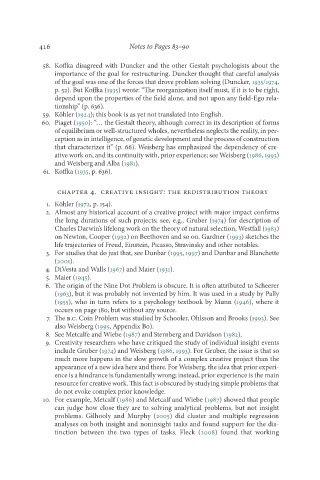Page 433 - Deep Learning
P. 433
416 Notes to Pages 83–90
58. Koffka disagreed with Duncker and the other Gestalt psychologists about the
importance of the goal for restructuring. Duncker thought that careful analysis
of the goal was one of the forces that drove problem solving (Duncker, 1935/1974,
p. 52). But Koffka (1935) wrote: “The reorganization itself must, if it is to be right,
depend upon the properties of the field alone, and not upon any field-Ego rela-
tionship” (p. 636).
59. Köhler (1924); this book is as yet not translated into English.
60. Piaget (1950): “… the Gestalt theory, although correct in its description of forms
of equilibrium or well-structured wholes, nevertheless neglects the reality, in per-
ception as in intelligence, of genetic development and the process of construction
that characterizes it” (p. 66). Weisberg has emphasized the dependency of cre-
ative work on, and its continuity with, prior experience; see Weisberg (1986, 1993)
and Weisberg and Alba (1981).
61. Koffka (1935, p. 636).
Chapter 4. Creative Insight: The Redistribution Theory
1. Köhler (1972, p. 154).
2. Almost any historical account of a creative project with major impact confirms
the long durations of such projects; see, e.g., Gruber (1974) for description of
Charles Darwin’s lifelong work on the theory of natural selection, Westfall (1983)
on Newton, Cooper (1992) on Beethoven and so on. Gardner (1993) sketches the
life trajectories of Freud, Einstein, Picasso, Stravinsky and other notables.
3. For studies that do just that, see Dunbar (1995, 1997) and Dunbar and Blanchette
(2001).
4. DiVesta and Walls (1967) and Maier (1931).
5. Maier (1945).
6. The origin of the Nine Dot Problem is obscure. It is often attributed to Scheerer
(1963), but it was probably not invented by him. It was used in a study by Pally
(1955), who in turn refers to a psychology textbook by Munn (1946), where it
occurs on page 180, but without any source.
7. The b.c. Coin Problem was studied by Schooler, Ohlsson and Brooks (1993). See
also Weisberg (1995, Appendix B0).
8. See Metcalfe and Wiebe (1987) and Sternberg and Davidson (1982).
9. Creativity researchers who have critiqued the study of individual insight events
include Gruber (1974) and Weisberg (1986, 1993). For Gruber, the issue is that so
much more happens in the slow growth of a complex creative project than the
appearance of a new idea here and there. For Weisberg, the idea that prior experi-
ence is a hindrance is fundamentally wrong; instead, prior experience is the main
resource for creative work. This fact is obscured by studying simple problems that
do not evoke complex prior knowledge.
10. For example, Metcalf (1986) and Metcalf and Wiebe (1987) showed that people
can judge how close they are to solving analytical problems, but not insight
problems. Gilhooly and Murphy (2005) did cluster and multiple regression
analyses on both insight and noninsight tasks and found support for the dis-
tinction between the two types of tasks. Fleck (2008) found that working

